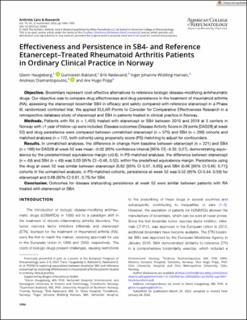| dc.contributor.author | Haugeberg, Glenn | |
| dc.contributor.author | Bakland, Gunnstein | |
| dc.contributor.author | Rødevand, Erik | |
| dc.contributor.author | Hansen, Inger Johanne Widding | |
| dc.contributor.author | Diamantopoulos, Andreas P | |
| dc.contributor.author | Pripp, Are Hugo | |
| dc.date.accessioned | 2024-02-12T08:36:01Z | |
| dc.date.available | 2024-02-12T08:36:01Z | |
| dc.date.created | 2023-03-31T13:09:56Z | |
| dc.date.issued | 2023 | |
| dc.identifier.citation | Arthritis care & research. 2023, 75 (9), 1986-1995. | en_US |
| dc.identifier.issn | 2151-464X | |
| dc.identifier.uri | https://hdl.handle.net/11250/3116757 | |
| dc.description.abstract | Objective Biosimilars represent cost-effective alternatives to reference biologic disease-modifying antirheumatic drugs. Our objective was to compare drug effectiveness and drug persistence in the treatment of rheumatoid arthritis (RA), assessing the etanercept biosimilar SB4 in efficacy and safety compared with reference etanercept in a Phase III, randomized controlled trial. We applied EULAR Points to Consider for Comparative Effectiveness Research in a retrospective database study of etanercept and SB4 in patients treated in clinical practice in Norway. Methods Patients with RA (n = 1,455) treated with etanercept or SB4 between 2010 and 2018 at 5 centers in Norway with ≥1 year of follow-up were included. Disease outcomes (Disease Activity Score in 28 joints [DAS28] at week 52) and drug persistence were compared between unmatched etanercept (n = 575) and SB4 (n = 299) cohorts and matched analyses (n = 172, both cohorts) using propensity score (PS) matching to adjust for confounders. Results In unmatched analyses, the difference in change from baseline between etanercept (n = 221) and SB4 (n = 106) for DAS28 at week 52 was mean –0.02 (95% confidence interval [95% CI] –0.32, 0.27), demonstrating equivalence by the predetermined equivalence margin (±0.6). In PS-matched analyses, the difference between etanercept (n = 49) and SB4 (n = 49) was 0.03 (95% CI –0.46, 0.52), within the predefined equivalence margin. Persistence using the drug at week 52 was similar between etanercept (0.62 [95% CI 0.57, 0.65]) and SB4 (0.66 [95% CI 0.60, 0.71]) cohorts in the unmatched analysis; in PS-matched cohorts, persistence at week 52 was 0.52 (95% CI 0.44, 0.59) for etanercept and 0.68 (95% CI 0.61, 0.75) for SB4. Conclusion Outcomes for disease status/drug persistence at week 52 were similar between patients with RA treated with etanercept or SB4. | en_US |
| dc.language.iso | eng | en_US |
| dc.rights | Navngivelse-Ikkekommersiell 4.0 Internasjonal | * |
| dc.rights.uri | http://creativecommons.org/licenses/by-nc/4.0/deed.no | * |
| dc.title | Effectiveness and Persistence in SB4- and Reference Etanercept–Treated Rheumatoid Arthritis Patients in Ordinary Clinical Practice in Norway | en_US |
| dc.type | Peer reviewed | en_US |
| dc.type | Journal article | en_US |
| dc.description.version | publishedVersion | en_US |
| cristin.ispublished | true | |
| cristin.fulltext | original | |
| cristin.qualitycode | 1 | |
| dc.identifier.doi | 10.1002/acr.25092 | |
| dc.identifier.cristin | 2138869 | |
| dc.source.journal | Arthritis care & research | en_US |
| dc.source.volume | 75 | en_US |
| dc.source.issue | 9 | en_US |
| dc.source.pagenumber | 1986-1995 | en_US |

